The late summer air is cool and heavy as I reach the trailhead. To hike through a forest at night is to move through a world dominated no longer by sight but by sound and smell. Nearing a spot on the trail I had identified earlier in the day, I stop, click off my flashlight, and allow my eyes to adapt to the inky darkness. I spot a soft greenish glow, appearing like a child’s nightlight in the distance, coming from the fallen trunk of a gray birch: here is what I have ventured out to find and photograph this evening – glowing mushrooms or, to put it more technically, bioluminescent fungi.
Bioluminescence is the emission of visible light by living organisms and involves a series of complex biochemical reactions that give off light as a byproduct. It is found in a few species of bacteria, fungi, algae, and insects. The most familiar example of this phenomenon comes from fields and woodland edges during the early summer, when fireflies use their ability to produce light as a means of identifying and attracting a mate. Many ocean-goers are familiar with species of fish and algae that glow at night. But in the woods, there lurks a familiar face whose nighttime glow may not be known: species of fungi that also have evolved the capability to produce living light. These glowing fungi have names such as torchwood, cold fire, fairy fire, foxfire, and fairy sparks, some dating back to the time of Aristotle, who was one of the first to comment on seeing glowing decaying wood.
The total number of fungal species is unknown. Best estimates place the number at upwards of 1.5 million, with less than 100,000 species currently described by scientists. To date, a total of 71 species of fungi are known to be bioluminescent, and of those the vast majority are found in tropical regions, with a few species inhabiting temperate environments. The light emitted is yellowish green or, less frequently, bluish green.
Which part of the fungus glows varies, depending on the species. For some, it’s the fruiting body (mushroom) or part of the fruiting body, such as the stalk or gills. For others, the glow emanates from the mycelium, the clusters of thread-like filaments called hyphae that compose the “body” of the fungus. The hyphae penetrate soil or woody substrates, absorb nutrients and water, and produce the fruiting bodies.
Three species of light-producing fungi are commonly found throughout North America: honey mushroom (Armillaria mellea), jack-o-lantern (Omphalotus olearius), and bitter oyster (Panellus stipticus).
Honey mushroom grows on decaying wood and is a well-known forest tree parasite that can be found from late summer through late fall in forests throughout North America, Europe, and Asia. It emanates a very low light from its mycelium. To see it well, you’ll need to let your eyes adjust to the dark for a good 15–20 minutes. When you do see it, the light pattern will appear as a series of patches or streaks and is the most common source of foxfire, a term that came from the French faux feu, or false fire. The term comes from the fact that nearly all the energy used in bioluminescence is given off as light and 4–5 percent as heat. By contrast, 90 percent of the energy used by an incandescent light bulb is released as heat and only 10 percent results in the production of light. This is why bioluminescence is also referred to as “cold light.”
Jack-o-lantern mushrooms can be seen cropping up around the base of stumps or standing dead trees from mid-summer to late fall. This species frequently occurs in large clusters and can easily be spotted by the bright orange mushroom caps, which can measure up to six inches in diameter. Bioluminescence occurs only in the gills of very fresh mushrooms where spores are still forming. The emitted light is generally very weak, although some specimens are reported to be bright enough to read by.
Bitter oyster (my personal favorite) is found in temperate forests on logs, stumps, and fallen branches of various hardwoods. Mushrooms can be found from mid-summer to late fall. The mushroom caps are small, the largest less than two inches in width. The caps are shell- or kidney-shaped, a dull offwhite to light tan in color, and often grow in overlapping clusters. Bioluminescence is emitted by the mushroom cap and is best observed in fresh specimens. Of the three species, this one produces the brightest glow.
So what might the adaptive advantage be, if any, of fungal bioluminescence? Scientists really don’t have the answers yet, although several hypotheses have been put forward. A glowing mushroom might be useful in attracting certain invertebrates that act as vehicles for spore dispersal, especially in a heavily canopied forest where wind may lose its effectiveness as a dispersal mechanism. Many fungi contain a number of toxic compounds such as alkaloids. The glowing mushroom could serve to advertise its toxicity in an effort to deter potential predators. All of the bioluminescent fungi identified to date are known wood-decayers and have the ability to digest the normally recalcitrant lignin molecule. Peroxides are byproducts of the process that can lead to increasing concentrations of oxygen, which could reach toxic levels in a cell. The chemical reactions involved in bioluminescence consume oxygen, and thus may act as a mechanism to alleviate oxidative stress, with the production of light simply a byproduct.
Regardless of the underlying biological basis for glowing fungi, one cannot help but take delight, as did Henry David Thoreau, in seeing this pale glow in a forest. In his book The Maine Woods, Thoreau describes his first encounter with “phosphorescent” wood:
“I little thought that there was such a light shining in the darkness of the wilderness for me … that the woods were not tenantless, but chokefull of honest spirits as good as myself any day … not an empty chamber, in which chemistry was left to work alone, but an inhabited house … and for a few moments I enjoyed fellowship with them.”


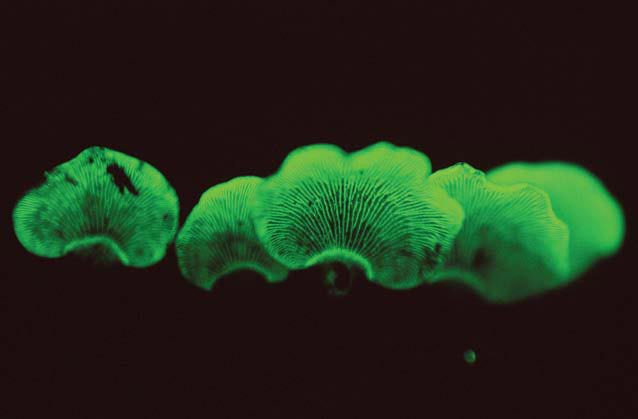
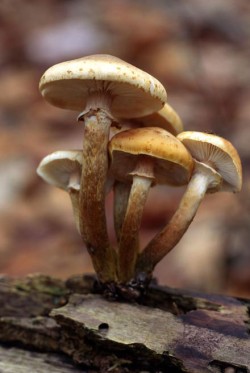
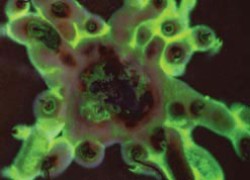
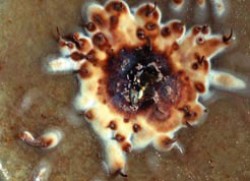
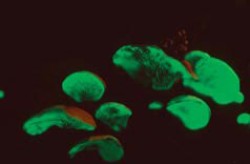
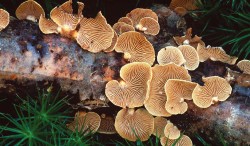
Discussion *